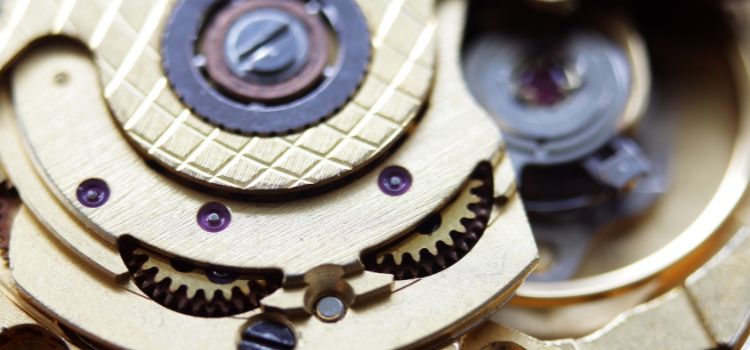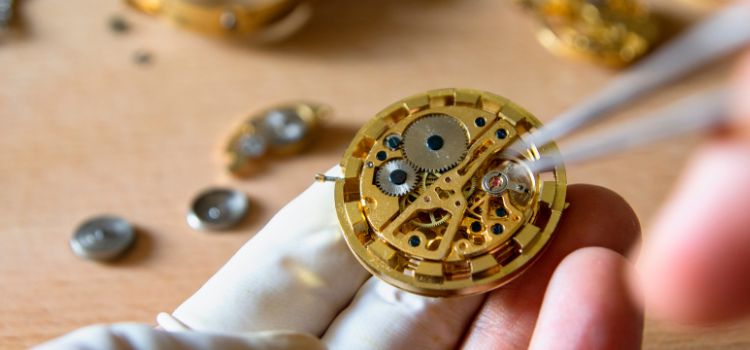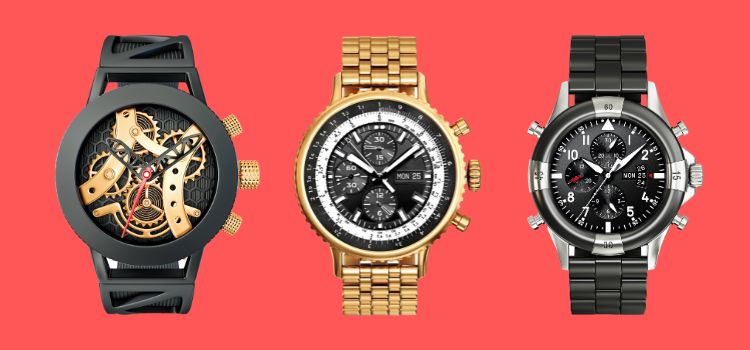As an Amazon Associate, I earn from qualifying purchases.
An incredible feat of horological engineering is an automatic mechanical watch. Mechanical watches use complex systems made of gears, springs, and other parts to measure time, unlike quartz watches run by batteries. In particular, automatic (also known as self-winding) mechanical watches use the wearer’s wrist movement to wind the mainspring, which serves as the main power source for the device.
History of Automatic Mechanical Watches
The first clockmakers started making portable timepieces in the fourteenth century when mechanical watches first appeared on the scene. These early watches were bulky and inaccurate, but they marked the beginning of the journey towards modern horology. Over centuries, technological advancements and craftsmanship led to the development of more precise and reliable watches.
The introduction of the automatic winding mechanism in the 18th century by watchmakers like Abraham-Louis Perrelet and later improvements by John Harwood in the 1920s revolutionized the industry. These innovations made mechanical watches more convenient, eliminating the need for daily winding and setting the stage for the widespread adoption of automatic watches.
How Mechanical Automatic Watches Work

1. The Mainspring
The mainspring is the heart of every mechanical watch, a tightly coiled spring that stores energy. In a manual watch, the wearer must wind the crown to tighten the mainspring. In an automatic watch, the mainspring is wound by the motion of a weighted rotor that spins as the wearer moves their wrist.
2. The Gear Train
Energy is transferred from the mainspring to the escapement via the gear train, which comprises several interconnected gears. This system of gears ensures that the power is released consistently, allowing for accurate timekeeping.
3. The Escapement
The escapement is one of the most critical components of a mechanical watch. By controlling its release, it transfers energy from the mainspring in exact, calibrated increments. This regulation is essential for maintaining the accuracy of the watch. The escapement works with the balance wheel, oscillating back and forth, dividing time into equal parts.
4. The Balance Wheel
The balance wheel and the hairspring control the rate at which the escapement releases energy. The balance wheel oscillates at a specific frequency, typically measured in beats per hour (BPH). Most modern mechanical watches have a frequency of 28,800 BPH, which translates to 8 ticks per second.
5. The Rotor
In automatic watches, the rotor is a semicircular weight that spins around the movement as the wearer moves their wrist. This spinning action winds the mainspring, providing a consistent energy source without the need for manual winding. The rotor is connected to the mainspring through gears and a ratcheting mechanism, allowing it to wind the mainspring in one direction while spinning freely.
Advantages of Mechanical Automatic Watches

a. Craftsmanship and Tradition
The artistry of making a mechanical automatic watch is one of its primary draws. These skilled watchmakers often assemble these timepieces, with many components being hand-finished. Watch enthusiasts highly value this dedication to craftsmanship and tradition.
b. Longevity
Mechanical watches are built to last. They can function for decades with proper care and maintenance, often becoming cherished heirlooms passed down through generations. Unlike quartz watches, which rely on electronic components that degrade over time, mechanical watches can be repaired and maintained indefinitely.
c. Eco-Friendliness
Since mechanical automatic watches do not require batteries, they are considered more environmentally friendly than quartz watches. When throwaway batteries are not utilized, the environmental effect of battery production and disposal is reduced.
d. Aesthetic Appeal
Mechanical watches often feature intricate designs with visible movements that showcase the complexity and beauty of the mechanism. Many high-end watches have exhibition case backs, allowing the wearer to admire the watch’s inner workings. Mechanical timepieces are attractive mostly due to their aesthetic appeal.
Types of Mechanical Automatic Watches

1. Dress Watches
Dress watches have sophisticated, modest designs and are used for formal events. They are typically thin, with simple dials and minimal complications. The focus is on classic aesthetics and refined craftsmanship.
2. Diver’s Watches
Diver’s watches are built for underwater use and are known for their robustness and water resistance. They usually feature luminous hands and markers, unidirectional rotating bezels, and screw-down crowns. These watches are designed to withstand high-pressure environments and are often tested to meet specific diving standards.
3. Pilot’s Watches
Pilot’s watches are designed with aviators in mind. They often feature large, easy-to-read dials, oversized crowns for operation with gloves, and additional complications like chronographs or GMT functions. The design emphasizes legibility and functionality.
4. Chronographs
Chronographs are watches with a built-in stopwatch function, allowing the wearer to measure elapsed time. To start, stop, and reset the timer, they usually have several subdials and pushers on the side of the casing. Chronographs are famous for their functionality and sporty aesthetic.
5. GMT Watches
GMT (Greenwich Mean Time) watches are designed for travelers and feature an additional hand to indicate a second-time zone. This complication helps keep track of time in different parts of the world, making it a favorite among frequent flyers and business travelers.
Maintenance and Care
a. Regular Servicing
Mechanical automatic watches require regular servicing to maintain their accuracy and longevity. It is recommended to have your watch serviced every 3-5 years by a professional watchmaker. During servicing, the watch is disassembled, cleaned, lubricated, and reassembled, ensuring all components function correctly.
b. Winding and Setting
While automatic watches wind themselves with regular wear, they may need manual winding if not worn for extended periods. To wind an automatic watch, gently turn the crown clockwise until you feel resistance. Avoid overwinding, as this can damage the mainspring. When setting the time, moving the hands clockwise is advisable to avoid damaging the movement.
c. Storage
It’s best to store your mechanical watch in a cool, dry place when not in use. Watch winders can keep automatic watches running when not worn, ensuring they remain accurate and ready to wear.
d. Cleaning
Maintaining the functioning and aesthetics of your watch is facilitated by routine cleaning. The case and bracelet should be cleaned with a gentle, lint-free cloth. For deeper cleaning, especially if the watch is water-resistant, you can use a soft brush and mild soapy water. Keep the watch away from strong chemicals and very hot or cold temperatures.
Collecting Mechanical Automatic Watches
1. Investment Value
Mechanical automatic watches can be valuable investments. Certain brands and models appreciate over time, particularly limited editions or pieces with historical significance. Collectors often seek watches from renowned manufacturers like Rolex, Patek Philippe, and Omega, which are known for their craftsmanship and enduring value.
2. Brand Heritage
The heritage and history of a watch brand play a significant role in its desirability. Brands with a long history of innovation and craftsmanship often produce highly sought-after watches by collectors. Learning about the heritage of different brands can enhance the appreciation of their timepieces.
3. Condition and Authenticity
When collecting watches, condition, and authenticity are paramount. Vintage watches in original, unaltered condition are typically more valuable. Collectors should seek reputable dealers and insist on documentation and provenance to ensure the authenticity of their purchases.
4. Community and Passion
Collecting mechanical watches is often driven by a passion for horology. Enthusiasts enjoy learning about the intricacies of watch movements, the history of watchmaking, and the stories behind individual pieces. The watch-collecting community is vibrant and welcoming, with numerous forums, clubs, and events where enthusiasts can share their knowledge and experiences.
Conclusion
Mechanical automatic watches are more than just timekeeping devices; they embody art, engineering, and history. Crafted with precision and care, their intricate mechanisms offer a tangible connection to centuries of horological tradition. Mechanical automatic watches continue to captivate and inspire, whether worn as a daily accessory, appreciated for their craftsmanship, or collected as valuable investments.
By understanding the workings, history, and maintenance of these remarkable timepieces, one can fully appreciate the enduring appeal of mechanical automatic watches. They testify to human ingenuity and watchmaking’s timeless pursuit of precision and beauty.
FAQs About Mechanical Automatic Watches

How does a mechanical automatic watch differ from a quartz watch?
A mechanical automatic watch is powered by a mainspring, wound by the wearer’s wrist movement, and utilizes an intricate system of gears and springs to keep time. In contrast, a quartz watch uses a battery to power a quartz crystal oscillator, which keeps time with great accuracy through electronic means. While mechanical watches are valued for their artistry and heritage, quartz watches are typically more accurate and require less upkeep.
How often does a mechanical automatic watch need to be serviced?
Mechanical automatic watches typically need to be serviced every 3-5 years. Regular servicing is essential to maintain the watch’s accuracy and longevity. During a service, a professional watchmaker will disassemble the watch, clean the components, lubricate moving parts, replace any worn-out parts, and reassemble the watch. Regular maintenance helps ensure the watch continues functioning correctly and can extend its lifespan significantly.
Can I manually wind my automatic watch, and if so, how do I do it?
Yes, you can manually wind an automatic watch. To do this, gently pull out the crown to its winding position (the first click) and turn it clockwise until you feel resistance. Typically, 20-40 turns are sufficient to wind the mainspring fully. Avoid overwinding, as it can damage the mainspring. Regular manual winding is not necessary if you wear the watch daily, as the natural motion of your wrist will keep it wound.
What should I do if my mechanical automatic watch stops running?
If your mechanical automatic watch stops running, it may have run out of power reserve. First, manually wind the watch by turning the crown clockwise 20-40 times. If the watch still doesn’t start, gently shake it to move the rotor and kickstart the movement. If these steps don’t work, the watch might need professional attention. It could require servicing and cleaning, or a mechanical issue could need to be addressed by a qualified watchmaker.
Are mechanical automatic watches water-resistant?
Many mechanical automatic watches are water-resistant, but the degree of water resistance varies by model. Water resistance is usually indicated on the watch case or in the accompanying documentation. Standard ratings include 30 meters (splash resistant), 50 meters (suitable for light swimming), 100 meters (suitable for swimming and snorkeling), and 200 meters or more (suitable for diving). It’s important to note that water resistance can diminish over time, so regular testing and maintenance of the gaskets and seals are recommended to ensure continued water resistance. Always follow the manufacturer’s guidelines regarding water exposure and avoid subjecting your watch to conditions beyond its rated capacity.
Amazon and the Amazon logo are trademarks of Amazon.com, Inc, or its affiliates.